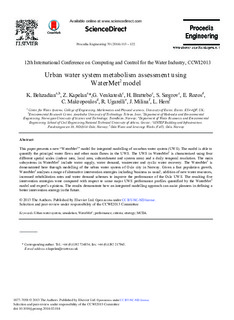| dc.contributor.author | Behzadian, Kourosh | |
| dc.contributor.author | Kapelan, Zoran | |
| dc.contributor.author | Govindarajan, Venkatesh | |
| dc.contributor.author | Brattebø, Helge | |
| dc.contributor.author | Sægrov, Sveinung | |
| dc.contributor.author | Rozos, Envangelos | |
| dc.contributor.author | Makropoulos, Christos | |
| dc.contributor.author | Ugarelli, Rita Maria | |
| dc.contributor.author | Milina, Jadranka | |
| dc.contributor.author | Hem, Lars John | |
| dc.date.accessioned | 2017-11-20T16:27:36Z | |
| dc.date.available | 2017-11-20T16:27:36Z | |
| dc.date.created | 2014-05-08T08:01:51Z | |
| dc.date.issued | 2014 | |
| dc.identifier.citation | Procedia Engineering. 2014, 70 113-122. | nb_NO |
| dc.identifier.issn | 1877-7058 | |
| dc.identifier.uri | http://hdl.handle.net/11250/2467224 | |
| dc.description.abstract | This paper presents a new “WaterMet2” model for integrated modelling of an urban water system (UWS). The model is able to quantify the principal water flows and other main fluxes in the UWS. The UWS in WaterMet2 is characterised using four different spatial scales (indoor area, local area, subcatchment and system area) and a daily temporal resolution. The main subsystems in WaterMet2 include water supply, water demand, wastewater and cyclic water recovery. The WaterMet2 is demonstrated here through modelling of the urban water system of Oslo city in Norway. Given a fast population growth, WaterMet2 analyses a range of alternative intervention strategies including 'business as usual', addition of new water resources, increased rehabilitation rates and water demand schemes to improve the performance of the Oslo UWS. The resulting five intervention strategies were compared with respect to some major UWS performance profiles quantified by the WaterMet2 model and expert’s opinions. The results demonstrate how an integrated modelling approach can assist planners in defining a better intervention strategy in the future. | nb_NO |
| dc.description.sponsorship | Acknowledgements. This work was carried out as part of the ‘TRansition to Urban water Services of Tomorrow’ (TRUST) project. The authors wish to acknowledge the European Commission for funding TRUST project in the 7th Framework Programme under Grant Agreement No. 265122. | nb_NO |
| dc.language.iso | eng | nb_NO |
| dc.publisher | Elsevier Ltd. | nb_NO |
| dc.rights | Attribution-NonCommercial-NoDerivatives 4.0 Internasjonal | * |
| dc.rights.uri | http://creativecommons.org/licenses/by-nc-nd/4.0/deed.no | * |
| dc.subject | Urban water system | nb_NO |
| dc.subject | Simulation | nb_NO |
| dc.subject | WaterMet2 | nb_NO |
| dc.subject | Performance | nb_NO |
| dc.subject | Criteria | nb_NO |
| dc.subject | Strategy | nb_NO |
| dc.subject | MCDA | nb_NO |
| dc.title | Urban water system metabolism assessment using WaterMet2 model | nb_NO |
| dc.title.alternative | 12th International Conference on Computing and Control for the Water Industry, CCWI2013 | nb_NO |
| dc.type | Journal article | nb_NO |
| dc.type | Peer reviewed | nb_NO |
| dc.description.version | publishedVersion | nb_NO |
| dc.rights.holder | © 2013 The Authors. Published by Elsevier Ltd. Open access under CC BY-NC-ND license. | nb_NO |
| dc.subject.nsi | VDP::Technology: 500 | nb_NO |
| dc.source.pagenumber | 113-122 | nb_NO |
| dc.source.volume | 70 | nb_NO |
| dc.source.journal | Procedia Engineering | nb_NO |
| dc.identifier.doi | 10.1016/j.proeng.2014.02.014 | |
| dc.identifier.cristin | 1131733 | |
| dc.relation.project | EC/FP7/265122 | nb_NO |
| cristin.unitcode | 7401,30,30,0 | |
| cristin.unitname | Infrastruktur | |
| cristin.ispublished | true | |
| cristin.fulltext | original | |
| cristin.qualitycode | 1 | |

